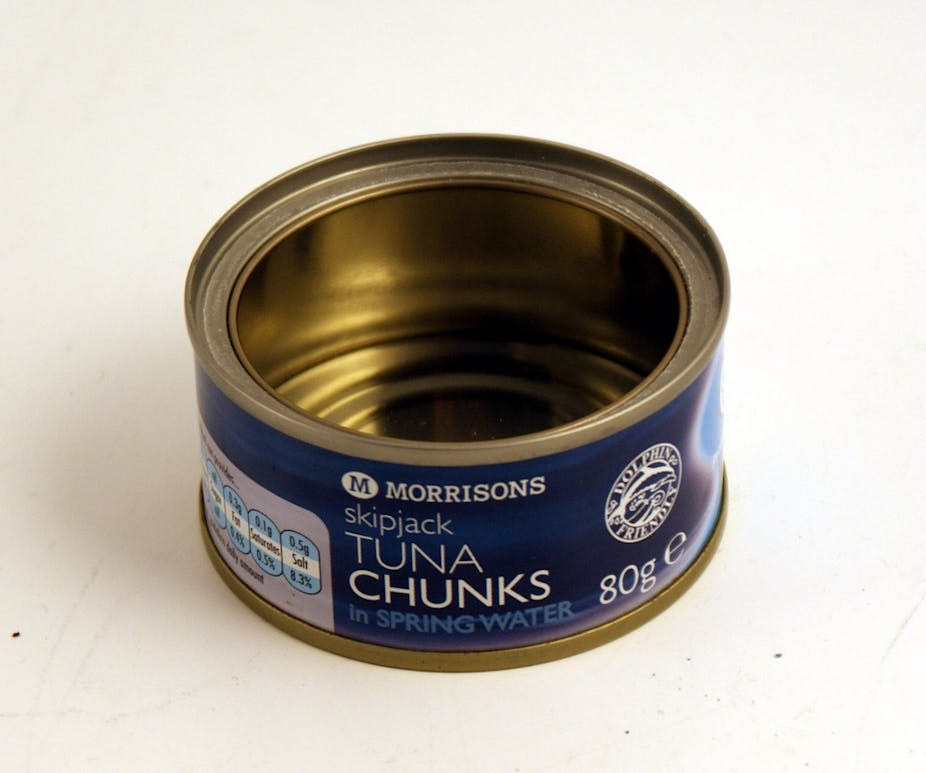Seafood is increasingly marketed as the clean, healthy choice for consumers – full of good oils and proteins and low in fat – with canned tuna a favourite cheap source of healthy protein. But science provides ever-worsening reports on the state of many fisheries, and their effect on marine ecosystems.
As international conservation negotiations flounder, consumers and industry are increasingly relying on eco-labelling to tell which seafood products come from sustainably managed fisheries. But there’s more to tuna than “dolphin-friendly”: what do these labels really tell us?
Labels need to tell the whole story of a fishery
Traditional fisheries management and early eco-labelling schemes only focused on target stocks or iconic species. They did not consider how fishing affected target, associated and dependent species or marine habitats.
But in recent decades, fisheries management has used two key principles: the “precautionary approach” and the “ecosystem based approach”.
Under the precautionary approach, managers have to be more cautious when information is uncertain, unreliable or inadequate. They can’t use the absence of adequate scientific information to defer conservation and management measures.
Under the ecosystem approach, managers can’t just think about the species being fished. They also have to keep populations of dependent and associated species at levels where they can reproduce, and protect important marine habitats.
These are important developments, making managers consider the broader ecosystem impacts of fishing. While some fishing methods can be highly selective and only capture target species, other fishing methods can heavily damage the marine environment and capture large numbers of associated and dependent species, subsequently discarded as “bycatch”.
For example, most canned tuna is caught using purse seine nets that encircle the school of tuna. If the purse seine net is set carefully around a free swimming school of tuna, this can be a reasonably selective method with little negative impact on the marine ecosystem. However, if the purse seine net is set on a school of tuna hiding under a drifting fish aggregating device (designed to attract fish), non-target species can also get caught up, and fished at unsustainable levels.
As fisheries management has evolved in recent decades, so too have the eco-labels and certification schemes. One of the key developments has been the move away from a single-species/issue focus towards broader assessments of entire fisheries management systems. These give consumers a far greater indication of sustainability and integrity.

How tuna-safe is dolphin-safe?
A team at the Australian National Centre for Ocean Resources and Security recently completed a peer reviewed study assessing different eco-labels and certification schemes currently used in Pacific tuna fisheries.
We looked at three different approaches to eco-labelling and certification:
- single-species eco-labels and certification schemes focused solely on iconic dolphins; such as the “dolphin-safe” label
- comprehensive ecosystem eco-labels offering sustainability certification of entire fisheries; examples include the Marine Stewardship Council and the Friends of the Sea
- seafood-industry associations with self-certifying sustainability claims; such as the International Seafood Sustainability Foundation.
In a literature review, we found tuna fisheries had unsustainable impacts on some species of tuna, shark, seabirds and turtles. But fishing impacts on dolphins were only a significant issue for a limited number of fisheries in the eastern Pacific. No credible threat to dolphin populations had ever been identified in the world’s largest tuna fishery - the Western and Central Pacific Ocean - nor raised in the relevant scientific and management organisations.
None of the single-issue dolphin-safe eco-labelling schemes comprehensively evaluated the status of tuna or other associated and dependent stocks in their certification processes. The ecosystem approach under the “Dolphin Safe” schemes was applied only in terms of how fishing affected dolphin populations.

Dolphin safe eco-labels could potentially mislead or create perverse incentives. For example, dolphin safe eco-labels in the UK may satisfy consumer anxiety regarding dolphins but do nothing to improve fishing practices or address broader conservation concerns. Almost all canned tuna sold in the UK is skipjack tuna, which does not associate with dolphins in the same manner found in eastern Pacific yellowfin tuna fisheries.
Well-managed fisheries may get no recognition for any other environmental credentials, while poorly managed fisheries with other serious environmental impacts may still claim to be environmentally friendly simply by being certified as dolphin safe. In neither case are consumers presented with the accurate and relevant information needed to make well informed decisions.
What does make a difference in tuna fisheries?
Modern eco-labels that apply ecosystemic and precautionary approaches provide far greater information to consumers. They provide certainty that seafood products did indeed originate from a sustainably managed fishery.
Two labelling systems provide this: the Marine Stewardship Council and Friends of the Sea.
The Marine Stewardship Council’s certification of the Pacific islands free-school skipjack fishery shows how important good certification can be. This eco-label has set an important precedent: this fishery – purse seine sets on free schools of skipjack tuna – has far less environmental impact when compared with purse seine fisheries that set on tuna hiding under fish aggregating devices.
If free-school sets were used throughout the Western and Central Pacific purse seine fishery instead of methods that set on fish aggregating devices, overfishing of bigeye tuna and oceanic whitetip sharks could be reduced to sustainable levels. It would increase the productivity of the relevant tuna stocks and significantly reduce bycatch of other species.
Eco-conscious consumers need labels that address the management of commercial species, fishing impacts on other species and on the broader environment, and standards of governance. It isn’t enough just to know your tuna is “dolphin-friendly”.

